With the warm Atlantic waters lapping at its door step, no city quite captures the essence of southern Spain like Cadiz. Aromas waft up from sidewalk-busting cafes leading to hundred year old trees shading cozy neighborhood squares. Majestic coastal fortifications once built to ward off marauding intruders now wrap pedestrians in a warm embrace, perched as they are high above the din of the city. Residents and Spanish tourists alike walk as if guided by deeply embedded cultural cues, as they seek out the most direct path to a siesta sponsored beach afternoon, towel and umbrella in tow.
I recognized very little of a city my parents insisted we visit on a quick vacation to Spain many decades ago. With only a handful of years under my belt, I remembered the name Cadiz, but painfully little else. Such is the curse of family trips with young children. Paradoxically, we struggle to remember now, cursed as our brains are with little room to store a lifetime of memories.
Yet, our attention and adrenaline were peaked after escaping the gauntlet of orcas the previous day. With a skip in our step, Karen and I took the long walk from Marina Puerto America, past busy industrial docks full of containers and Covid quarantined cruise ships, to the fortified gates of the old Cadiz city center. This was our ‘big city’ experience in Spain. Big this time didn’t mean more Americans. Any U.S. parents intending to bring their small children on a family holiday had apparently decided to stay home. We continued to be surrounded by Spanish speaking locals, and though we had to bumble our way along with merchants and waiters, it left us with a refreshingly authentic experience.



One of the enduring qualities of European travel, and one that I know I will look back on fondly when I am bound to an arm chair, is the daily food markets. In small towns, this might consist of only one or two vendors, but still, there is fresh meat and produce within easy reach. Cadiz was no different, with the historic Mercado Central, located conveniently in the center of the old city. It was designed in a neo-classical style back in 1837 on the site of an old orchard owned by the Convento de Los Descalzos (Convent of the Barefoot Friars). Today, bare feet would be frowned on, as well as unmasked visitors. The neo classical porticos on the perimeter hemmed in the brutalist modern concrete center building, a modern day compromise of form and function. With the Atlantic just steps away, the fare was heavily weighted in favor of fresh fish, which served as a fresh reminder to the crew of Sea Rose to take advantage of this huge selection before settling for a more limited choice back home.

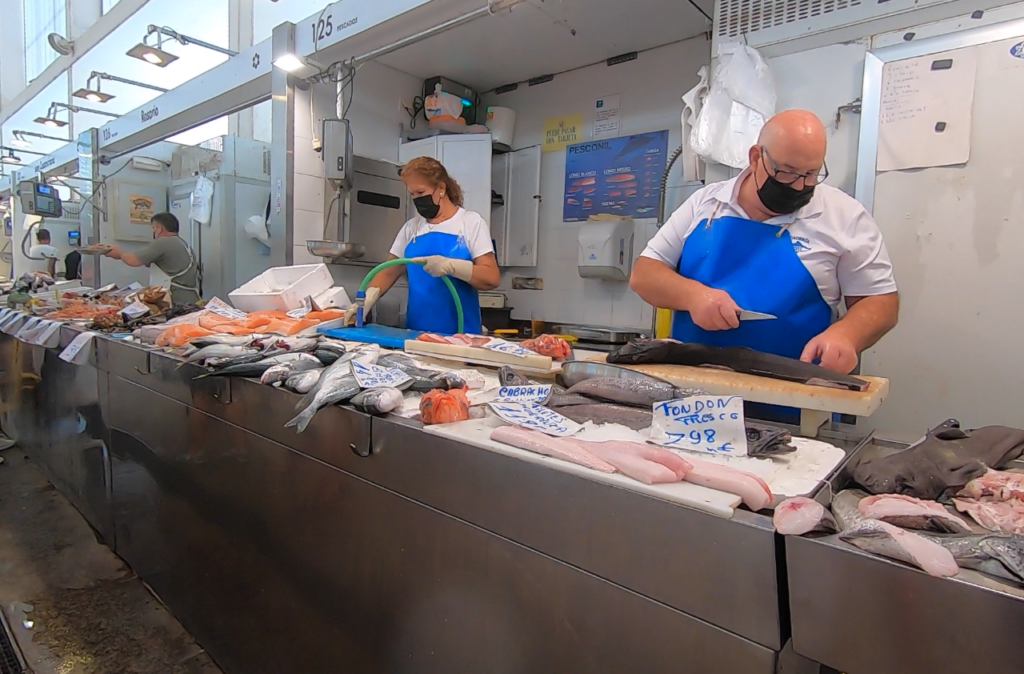
With two gloriously calm nights onboard Sea Rose in a marina, we slept like babies after dawn-to-dusk days full of walking.

We wished the beach goers well as we pointed the bow of Sea Rose out of the Bahia de Cadiz at first light, bound for Mazagon 45 miles away. From the best reports we could obtain, it seemed like the greatest risk of orca attacks was behind us, but we maintained a vigilant watch nonetheless for anything unusual breaking the surface of the water in our vicinity. From our research, this stretch of the Atlantic Spain coast was a bit harder to categorize, and therefore more challenging to set expectations. In the Gibraltar Strait, you know you’ll be facing heavy ship traffic and intense microclimate shifts. North to Cadiz had been occupied by orcas and twisting coast lines. But from Cadiz, the low lying shore faded away in the early morning light as if there was no beginning nor no end, a kind of mercurial fog that defied the laws of both physics and linguistics.
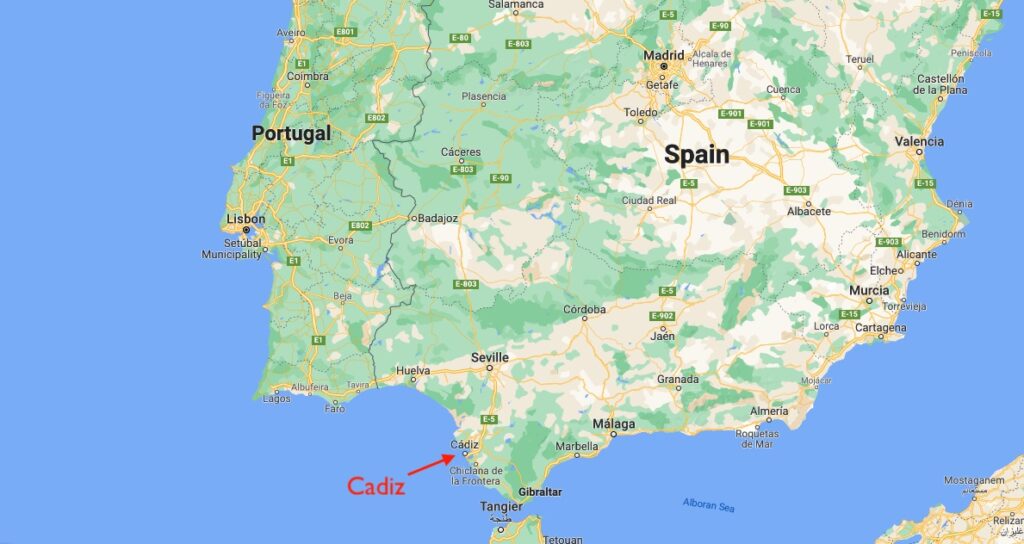
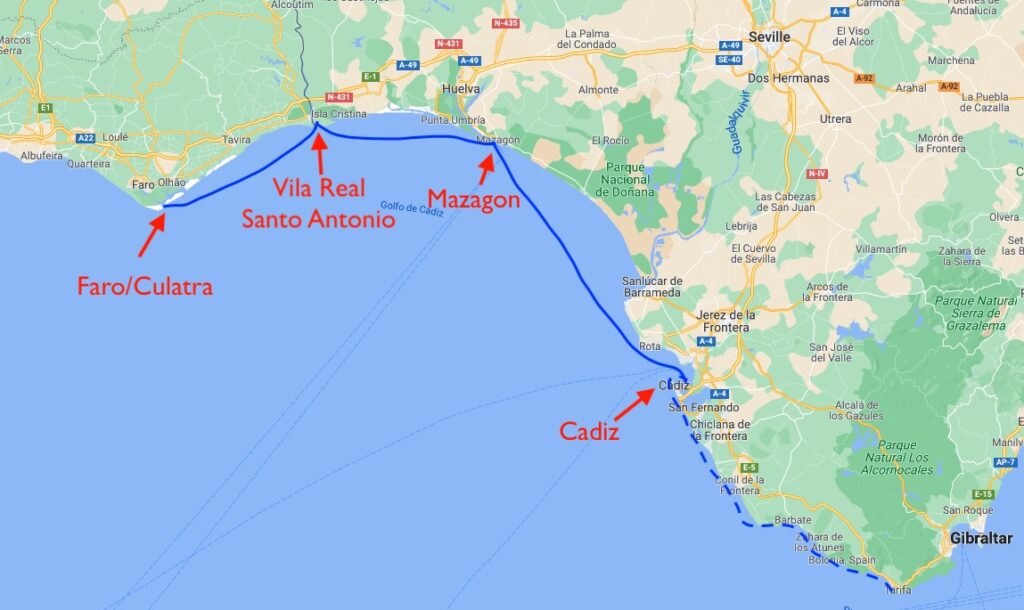
So you might sympathize with our startled reaction when over the VHF radio came a male voice speaking crisp American English, as if he had just been plucked from a diary farm in Wisconsin, announcing himself as ‘This is War Ship 78 on a course of 245 calling the sailboat crossing our bow’. We could see in the hazy distance a military ship leaving Cadiz, and we felt compelled to call them back on the radio to ask if we were the offending sailboat. What followed was a radio conversation more suitable for the U.S. airwaves, as a California guy talked to a U.S. Navy officer about avoiding each other in the territorial waters of Spain. It felt like the twilight zone. As we motored away, and for the next two hours until we were beyond radio range, we continued to hear Wisconsin boy radioing ‘Securite’ messages. Now, I’m all for local Navy vessels warning you to keep a safe distance from their training exercises at sea. I just had a little issue with the words ‘war ship’. I’ve never heard the U.S. Navy identify themselves this way back home. Where was the ‘war’?And how did Spaniards feel about a U.S. war ship plying their waters and calling on the radio in English only. Our experience with government vessels elsewhere in Europe was in both the local language and in English. ‘War ship 78’ seemed a bit heavy-handed. I sure would have preferred my countrymen and women announce themselves as ‘U.S. government vessel’, with a translation by any number of eager local service personnel in their native language. But I digress!
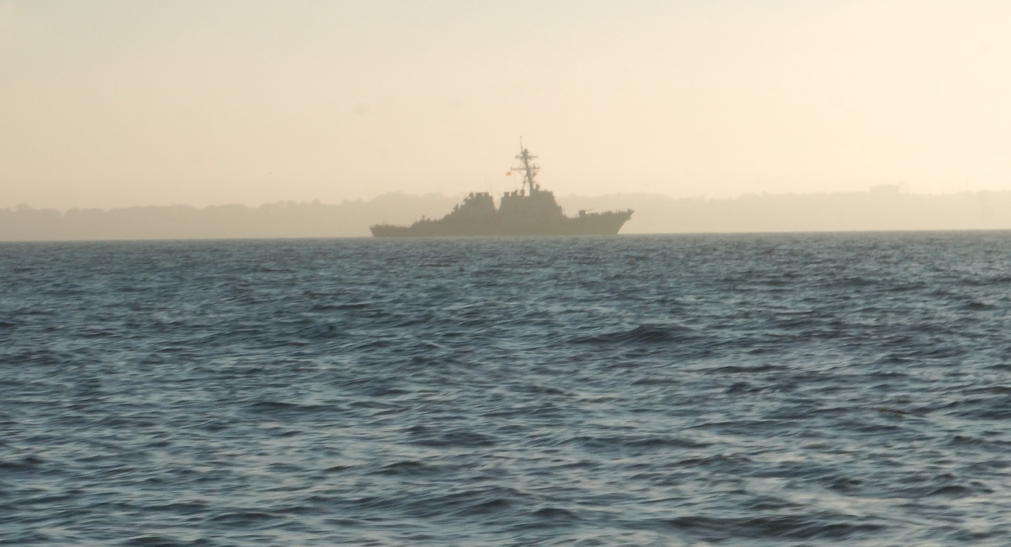
The wind forecast, along with the shoreline, was hard to nail down, but soon we were getting a light breeze out of the west, giving us a pleasant close-hauled sailing angle. With it, we navigated to the entrance of the Rio Odiel, a heavily commercialized estuary, the nature of which was made glaringly obvious by the 14 freighters anchored offshore, including container ships and oil tankers. The Puerto Deportivo de Mazagon was just inside the river entrance, a great relief from having to compete for space in the narrow channel with ships many hundreds of times our size.
As it so often seems, we arrived during the siesta hours of the afternoon. Thankfully, the marina had a reception pontoon, a fantastic concept that we hope is a more common occurence in our future. One of the big challenges when entering a new-to-you marina is to try to manage the simultaneous assessment of the marina layout, the calls over the VHF with marina personnel speaking limited English, various marina staff motioning to you visually from hard-to-discern spots between docked boats, and the general wayward nature of other local commercial and private boats. A reception pontoon gives you a ‘waiting room’ of sorts to get docked, talk face to face with the marina staff, get fuel, and maybe even walk over to where you will dock to assess the maneuverability of the location. As it turned out, only one marina person was available during siesta and we appreciated the opportunity to wait on the pontoon for clear instructions.
Mazagon is reported to be the location where Christopher Columbus originally set sail, and a replica of his ship was rumored to be docked at the marina, but we found no sign of it. Instead, we discovered a new world of our own, full of local shops and restaurants without a care in the world for the tourist trade. It was actually quite renewing. The Spaniards must have suffered hard during the Covid lockdowns, as it became rapidly clear to us when we started looking for a place to have dinner. Every human being in town that could walk was on the prowl for dinner and, unlike us, had made reservations well in advance. At 8pm, as we searched in vain for an open reservation, restaurants were just waking up and wait staff were pulling inverted chairs off of outdoor tables while clearing the siesta sleepiness from their eyes. It was hard to imagine that not one free table from this empty oasis was available. Finally, we secured an early evening spot inside at one venue, all the while wondering if space was available here because of a prior disease outbreak, questionable allegiance to the local football team, or a scandalous affair by the owner’s daughter. We started off alone, but when the true commencement of European dining came at 10pm, every table inside and out was crammed to capacity, and the food was outstanding.


With nothing keeping us in Mazagon, we were once again off at first light westbound to the Rio Guadiana, the river of demarcation between Spain and Portugal. No recent reports had been filed of orca attacks along this low-lying stretch of coast, and we began to dial back our vigilance ever so slightly. In its place, we kept a close eye for numerous fish buoys, and the small fishing craft that accompanied them. In the calm waters of this stretch of mild winds, the buoys were easy to pick out, but distinctly different with their boxy white shapes. We were just happy they bore no resemblance to a black and white dorsal fin.

With no wind to fill our sails, we motored throughout the morning, slowing our speed in order to arrive at the Vila Real Santo Antonio marina, at the entrance to the Rio Guadiana, during slack current. These rivers carry a long distance inland, receiving both the incoming tidal waters of the Atlantic and the drainage of rain water from deep in the interior. As such, boaters have to closely evaluate the times for slack current, unless you enjoy leaving the collision risk with rocks, anchored boats, and shoals to the forces of Mother Nature. In the U.S., we had become very accustomed to looking up the peak and slack current times and their speed in knots. But we found no clear source for this same information in Spain. The Navionics chart data simply showed high and low tides, but every river was different when it came to the timing of slack versus the tide. Slack can often occur hours after high and low tide. Making the palms sweat even more was the intel we had on the marina, where prior boaters had commented on the surprising strong river current that flowed right through the marina docks. This was combined with the words of caution on the minimal size of the marina entrance which was shorter than the length of Sea Rose and would have to be entered at a perpendicular angle to the river, with its powerful current. This presented a challenging geometry problem of aiming for a point up current from the entrance, hoping that your chosen angle was timed right to put you at the middle of the opening, without a crowd-stirring spectacle of one’s bow riding up the adjacent dock on either side.
We finally found a setting buried in the menus of the chart plotter that allowed us to see the direction and strength of the current. With this new intel, we continued to slow our motoring to aim for a slack water entrance. This was also critical for negotiating the outer channel entrance, where a literal river of current dumped into the Atlantic. If you hit this spot at the wrong time, you could be hobby-horsing your boat over large and irregular standing waves.
Many boaters entering the Rio Guidiana take advantage of the generous water depths to follow the salamandering path up river to the village of Alcoutim, but we would clip off the top of our mast if we tried to get under the first bridge. Instead we settled on the excitement of shooting the narrow gap into the marina at Vila Real de Santo Antonio as our welcome to the country of Portugal. The water had been fairly slack at the river entrance, but now, as we approached the marina, there was a healthy ebb of water racing through the pontoons. If we were successful shooting the entrance, we’d have to run along the inside edge of the outer pontoon and effectively parallel park Sea Rose while the water tried to yank us backwards into the pointy bow of the boat just downstream of us. After living in hilly San Francisco, Karen and I were no strangers to challenging parking situations, but today’s parking would be difficult even if there was no current. Three cheery marina guys eagerly waved to us from the outer pontoon. With promises of their docking assistance, Karen revved up the diesel, pointing the bow to the up current end of the gap until the last moment. We then throttled back to make just enough headway over the current. Boat owners arose from their cabins as we passed closely by, sizing us up to see if we were fit for the challenge. I find people in these situations generally amiable, perhaps even offering some tidbits of advice, but this often seems like a cover for their own concern and self-preservation against damage to their own boat. We all do it, as we weigh the risk of careless damage from another boater versus the immense sweat equity we have put into our own.
With remarkable aplomb, Karen shoehorned us in to the skinny opening between two larger boats, we had lines secured without incident, and our helpful marina folk headed off for siesta. The current was so strong, juvenile widemouth bass were feathering their way upstream while hiding behind our rudder. Yet we were safe and sound once again, and we headed into the town to absorb the Portuguese experience.
This stretch of the Portuguese coast is called the Algarve, and owing in large part to the proximity to Lisbon, it’s a very popular destination. Holiday makers seem to be singularly focused on the beach and the Algarve has every variety from long, flat, as-far-as-you-can-see beaches to cliffy versions that require a course in mountaineering in order to descend to the sand. When the day’s adventure is over, there’s no shortage of bounty from the sea offered on your dinner plate as it seems Portuguese fishing boats ply these waters more aggressively than anywhere else. We found the village of VRSA, as it is called, teeming with visitors overheated in the late afternoon sun, looking for a place to quench their thirst and perhaps renew their soul. Ice cream was for sale everywhere, but we eventually found a simple outdoor cafe with plenty of empty seats. A couple next to us had already been given menus but after many attempts to flag down a waiter, they abruptly got up and left. Soon, we were doing the same, confused as to whether this was a consequence of staff shortages or unwillingness to deal with foreigners. To be fair, Portuguese is not an easy language to learn, and we were still trying to practice the basic ‘please’ and ‘thank you’. When we were left unserved again at a second cafe, our Algarve welcome was starting to sour. A cold beer from the fridge of Sea Rose held no drama.

Determining the precise time of slack current for our morning’s departure was still a challenge. At dawn, ready to drop lines based on best current predictions, the river flow was far from slack so we decided to take an hour break. When the current still didn’t ease, we decided it would be best to leave rather than chance it with heavier current and building winds. To an outside observer (of which there can be many), Karen and I probably spend too much time talking through the dropping of lines when we leave a dock. We discuss the pros and cons of leaving bow or stern untethered first, whether the spring lines have enough pressure to keep on until the last minute, and so on. While some other boaters just drop and go, we’ve found that this extra effort reduces the stress and drama when you actually let go of the dock. This morning, we had a steady flow of current running directly down the boat from bow to stern. Our plan involved dropping the stern line last, while Karen kept the throttle at a position that would hold the boat steady relative to the dock. Then, as I climbed onboard at the stern, she would steer away from the dock and the current would accelerate our 180 degree rotation before the bow struck the adjacent pontoon. It took some quick action to hop on the boat with the help of the bimini frame, and some deft helmswoman work. But I felt any doubters onshore at this early hour would have had to find some other stock options to short.

It had been a breezy start at the dock and by the time we steered out into the Rio Guadiana, winds were steady at 20 knots offshore, giving us a lively beam reach sail towards our destination at Faro. It was a moderate distance of 30 miles, but the entrance at Faro was another unpredictable affair with rumors of high standing waves breaking over a bar. The weather forecast called for the high winds to diminish in an hour, followed by a light southerly wind. It’s reassuring when the forecast paints an exact picture of reality, and right on cue, the southern winds graced us with a gentle sail along the coast. This stretch of shoreline is doted with tuna nets clearly marked with cardinal buoys on the chart. You have to pay close attention, as you can easily stumble your way inside these net areas and not realize it until the last minute due to low lying nature of the fishing gear.

Along with the tuna, other marine life was quite active near these nets, and as we slowed to negotiate a turn around one of the cardinal buoys, a dorsal fin suddenly surfaced next to us and I jumped, still showing the nerves of our recent orca close encounters. It ended up being an innocent porpoise.
As we approached the narrow entrance to Faro, white water from cresting waves became visible, as did several small fishing boats. It seemed like they were slowing down to negotiate the turbulence, but once we came abreast of them, it was clear they were actually anchored here. It was hard to hold back our frustration. It’s not safe nor legal to anchor in a navigation channel, particularly one like this with waves and whirlpools that make holding a straight course a near impossibility. Yet, the fishing was probably excellent and how can I, in my private pleasure boat, deny another human the opportunity to put food on the table. Karen gripped the wheel extra firm and we pushed on through.

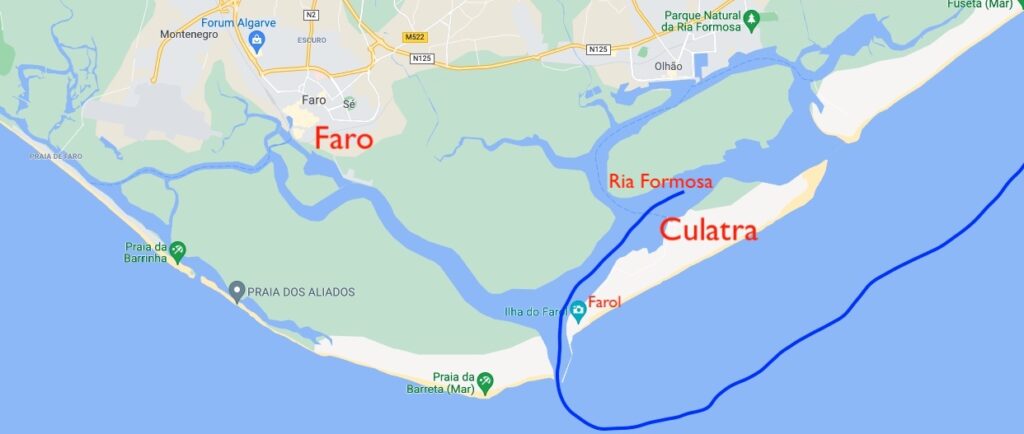
Inside, the channel forks left to the actual city of Faro and right to a large lagoon named Ria Formosa protected by the long, skinny island of Culatra. At least 100 boats were anchored off the Culatra ferry landing, and easily another 100 were anchored in the narrower reaches beyond. This was more anchored boats than we had seen in one place since the Ionian islands of Greece. Protected as it was from any wind borne seas, the only challenge we had was adapting to anchoring in tidal conditions. Up until now, we had been spoiled by the half meter tides of the Med. Here, the tide swung 2.5-3 meters – very similar to our home waters of Maine. We had to relearn old habits of checking to see where you are in the tide cycle before dropping the anchor, and factoring in the right scope for high tide. We had to make sure our anchor held, as we would be spending several days here so that I could find a good doctor for a developing eye problem. But, that is a story for another day!


